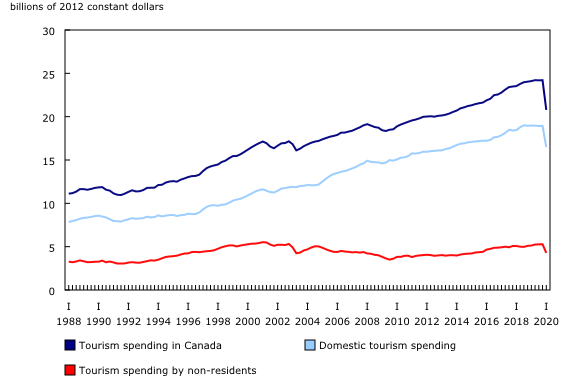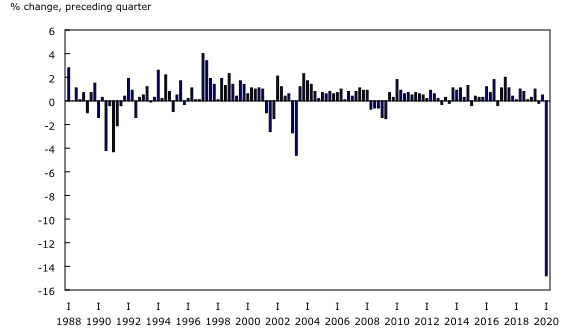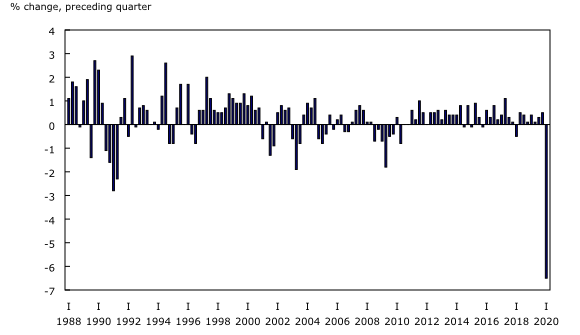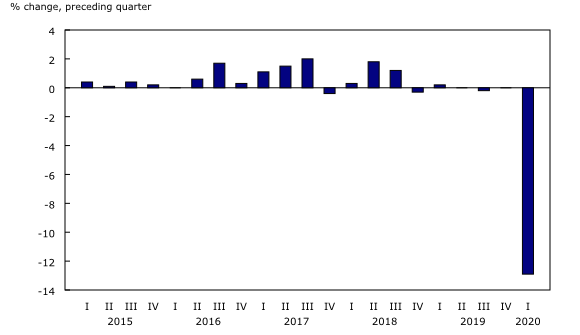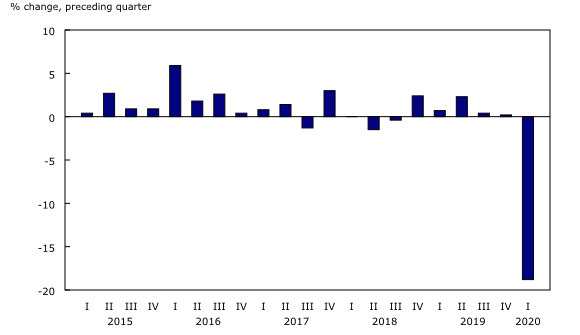National tourism indicators, fourth quarter 2019 and first quarter 2020
Archived Content
Information identified as archived is provided for reference, research or recordkeeping purposes. It is not subject to the Government of Canada Web Standards and has not been altered or updated since it was archived. Please "contact us" to request a format other than those available.
Released: 2020-06-30
Tourism spending in Canada fell 14.2% in the first quarter—the largest decline on record—in the wake of measures imposed to contain the COVID-19 pandemic in March. Tourism gross domestic product (GDP) decreased 14.8%, while jobs attributable to tourism fell 6.5%, both also the largest quarterly declines since the data series began in 1986.
Spending was down in all major tourism categories, led by passenger air transport (-15.7%), food and beverage services (-15.5%) and accommodation (-13.8%). The decline in spending on passenger rail transport (-39.1%) was particularly severe, with rail blockades also resulting in a number of route cancellations earlier in the quarter.
Tourism GDP fell 14.8% in the first quarter, following a 0.5% increase in the fourth quarter of 2019. Economy-wide GDP decreased 2.1%, highlighting the difficulties faced during a global pandemic. Tourism's share of Canada's GDP declined from 2.0% in the fourth quarter of 2019 to 1.7% in the first quarter of 2020.
Meanwhile, employment attributable to tourism fell 6.5% in the first quarter, following a 0.5% gain the fourth quarter of 2019. Food and beverage services (-8.9%) and accommodation (-6.9%) contributed most to the decline in tourism employment. Tourism employment in air transportation (-1.9%) also decreased. Overall, employment in Canada declined 3.5% in the first quarter and tourism's share dropped to 3.7%.
Tourism spending by Canadians in Canada down sharply
Tourism spending by Canadians in Canada dropped 12.9% in the first quarter, following no change in the previous quarter. Domestic tourism accounted for 79% of tourism spending.
All tourism categories were down, with passenger air transport (-14.3%), food and beverage services (-14.4%) and vehicle fuel (-13.4%) contributing the most to the overall decline.
Spending by international visitors down by almost one-fifth
Tourism spending by international visitors to Canada fell by a record 18.8% in the first quarter, following a 0.2% increase in the fourth quarter of 2019. The number of travellers to Canada fell sharply, as travel was restricted and borders closed to contain the spread of COVID-19 during the second half of March. The Canadian border was closed to non-essential foreign travellers from countries other than the United States on March 18, and to those from the United States on March 21.
Passenger air transport (-21.3%), accommodation (-18.8%) and food and beverage services (-19.0%) contributed most to the drop in tourism spending by international visitors.
Sustainable development goals
On January 1, 2016, the world officially began implementing the 2030 Agenda for Sustainable Development—the United Nations' transformative plan of action that addresses urgent global challenges over the next 15 years. The plan is based on 17 specific sustainable development goals.
The national tourism indicators are an example of how Statistics Canada supports the reporting on the global goals for sustainable development. This release will be used in helping to measure the following goal:

Note to readers
Growth rates for tourism spending and gross domestic product (GDP) are expressed in real terms (that is, adjusted for price changes), using reference year 2012, as well as adjusted for seasonal variations, unless otherwise indicated. Employment data are also seasonally adjusted. Tourism's share of economy-wide GDP is calculated from seasonally adjusted nominal values. Tourism's share of economy-wide employment is calculated using seasonally adjusted values. For information on seasonal adjustment, see Seasonally adjusted data – Frequently asked questions.
Associated percentage changes are presented at quarterly rates unless otherwise noted.
Economy-wide GDP is obtained from table 36-10-0104-01. Economy-wide employment is obtained from table 36-10-0207-01.
With this release of the national tourism indicators, all data for the first, second and third quarters of 2019 have been revised.
The national tourism indicators are funded by Destination Canada.
Next release
Data on the national tourism indicators for the second quarter of 2020 will be released on September 30, 2020.
Products
The data visualization product "Provincial and Territorial Tourism Satellite Account," which is part of Statistics Canada – Data Visualization Products (71-607-X), is available.
The Economic accounts statistics portal, accessible from the Subjects module of our website, features an up-to-date portrait of national and provincial economies and their structure.
The Latest Developments in the Canadian Economic Accounts (13-605-X) is available.
The User Guide: Canadian System of Macroeconomic Accounts (13-606-G) is available.
The Methodological Guide: Canadian System of Macroeconomic Accounts (13-607-X) is available.
Contact information
For more information, or to enquire about the concepts, methods or data quality of this release, contact us (toll-free 1-800-263-1136; 514-283-8300; STATCAN.infostats-infostats.STATCAN@canada.ca) or Media Relations (613-951-4636; STATCAN.mediahotline-ligneinfomedias.STATCAN@canada.ca).
- Date modified:



